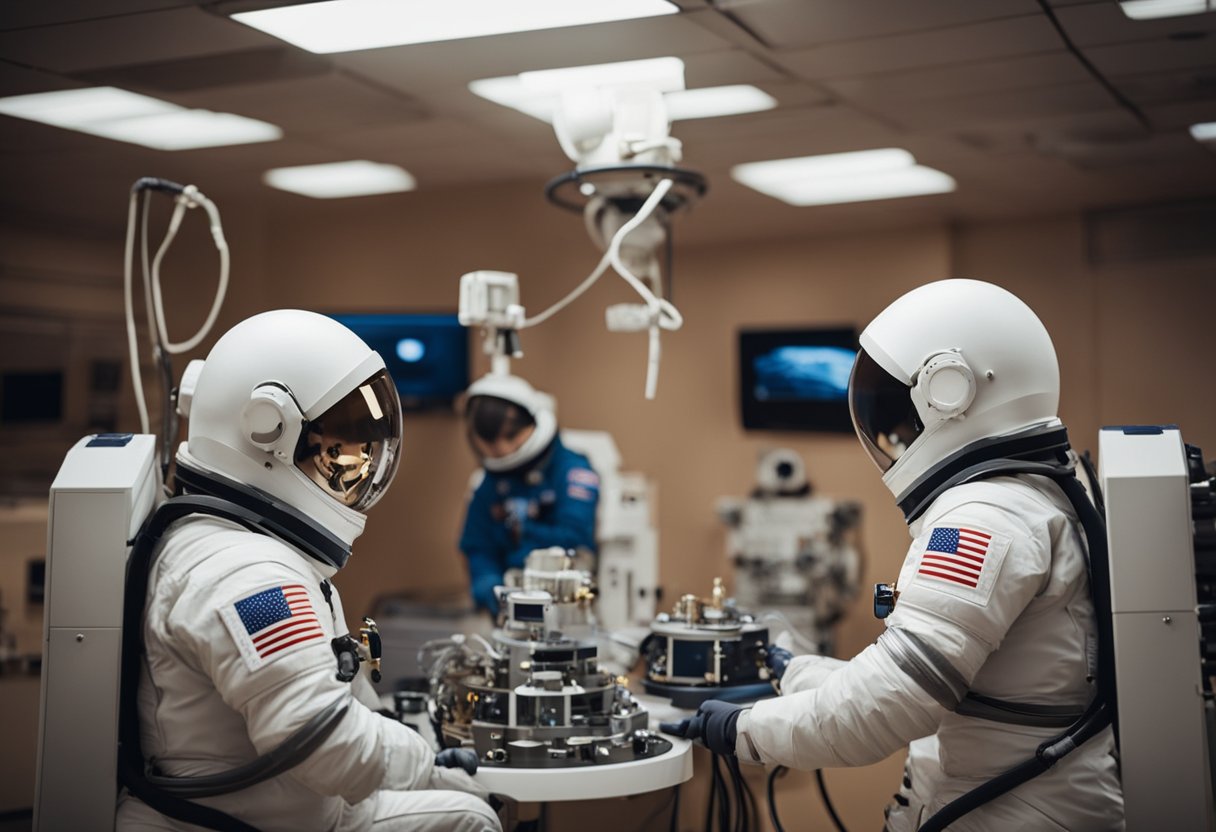
Space mission simulation experiences offer an unparalleled glimpse into the rigours and wonders of space travel without ever leaving the Earth. These simulations mimic the various phases of spaceflight, from pre-launch to landing, and provide valuable training for astronauts as well as education and engagement for the public. Virtual reality technology has become a key tool in these simulations, generating immersive environments that replicate the vastness of space and the interior of spacecraft like the International Space Station.
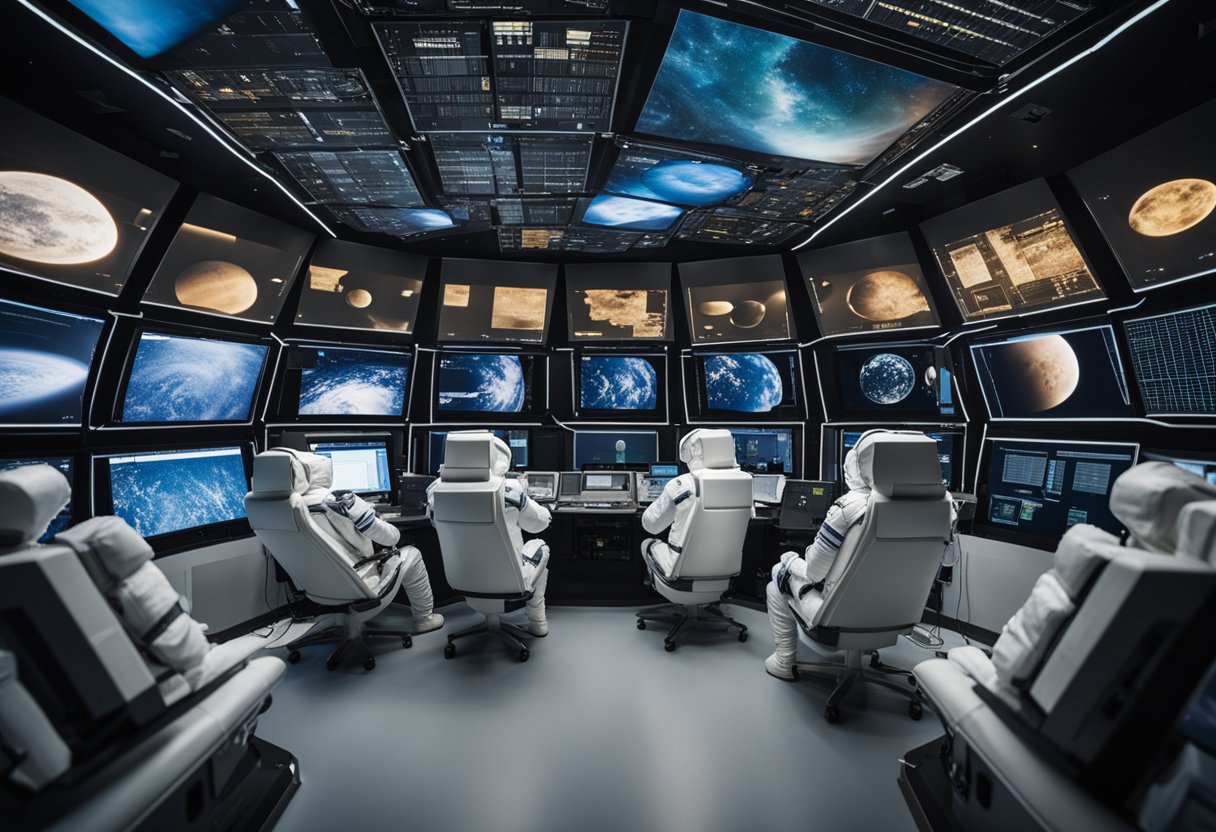
Educators and space agencies worldwide are utilising simulation experiences to ignite interest in space exploration and STEM (Science, Technology, Engineering, and Mathematics) fields. Through programs at institutions and facilities dedicated to space simulation, participants can gain insights into the teamwork, problem-solving, and technical skills required for space missions. These experiences are also crucial for testing protocols and hardware, increasing safety and efficiency for real missions.
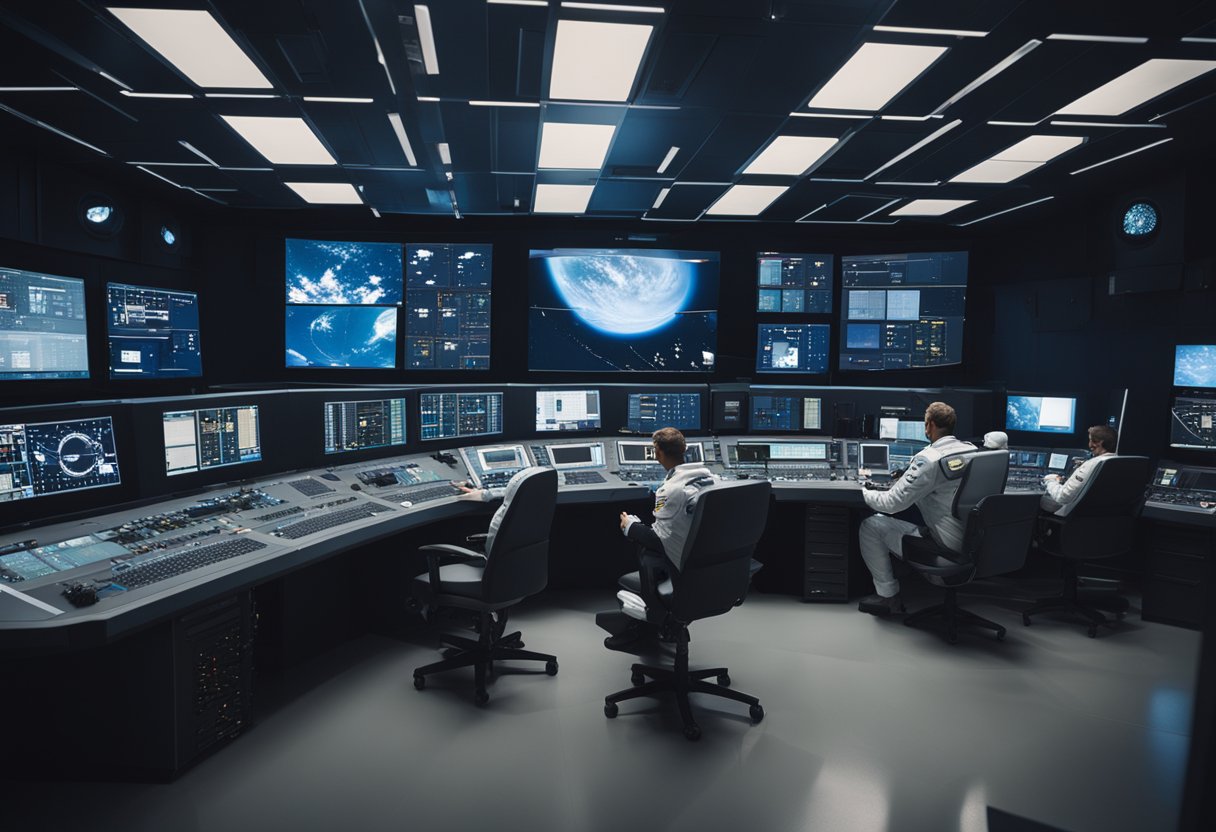
In the timeline of space exploration, simulations have been pivotal in preparing for and executing missions. They bridge the gap between theory and practice, ensuring astronaut safety and mission success.
In the genesis of space simulation, NASA took a leading role, particularly through the Johnson Space Center, which has been at the forefront of conceptualising and implementing these training models. The early Apollo missions set a precedent with complex training that allowed astronauts to familiarise themselves with spacecraft systems and expected scenarios in space. Such preparations were critical in navigating the unforeseen circumstances faced during the Apollo 13 mission, demonstrating the necessity of comprehensive simulation in space exploration.
Advancements in technology have transformed the landscape of space mission simulations. Today, we possess far more sophisticated and realistic virtual environments thanks to developments in computer graphics and modelling techniques. The involvement of agencies like the Canadian Space Agency (CSA) in collaborative training exercises has further broadened the scope and depth of space simulations.
Moreover, initiatives such as the survey conducted by the Vienna-based company for the European Space Agency (ESA), have helped envision future simulation facilities and methodologies. With the advent of private spaceflight companies and prospective space tourism ventures like SpaceVoyageVentures.com, the boundary of simulations extends beyond government agencies, preparing not just astronauts but also civilians for the experience of space travel.
In crafting simulations for space missions, we utilise a variety of methods to prepare astronauts for the challenges of space travel and to conceptualise virtual space tourism experiences. These simulation types range from physical mock-ups to highly advanced digital environments.
We often deploy analogue missions to train astronauts and simulate space environments here on Earth. These missions involve sending crews to remote, extreme locations that mimic extraterrestrial landscapes, such as deserts or underwater habitats. This hands-on approach allows astronauts to experience conditions similar to those they would encounter in space, such as isolation and limited resources.
Digital simulators are pivotal in our preparation for space missions and provide a detailed understanding of spacecraft and mission operations without leaving the ground. These simulators encompass commercial software that models interconnected elements like orbit and ConOps, as well as bespoke scripts for more straightforward modelling tasks. An example includes our ability to simulate various mission elements such as the Artemis Program and its complexities.
Virtual reality-based simulators have introduced an immersive dimension to space mission preparations and conceptual tours for the burgeoning space tourism sector. By employing virtual reality, we create multiuser environments enabling astronauts—or potential space tourists visiting websites like SpaceVoyageVentures.com—to experience and interact with space settings in a simulated yet realistic manner. An example of this technology in action is a multi-user virtual reality experience for space missions, which can significantly aid in human behaviour studies under extreme conditions.
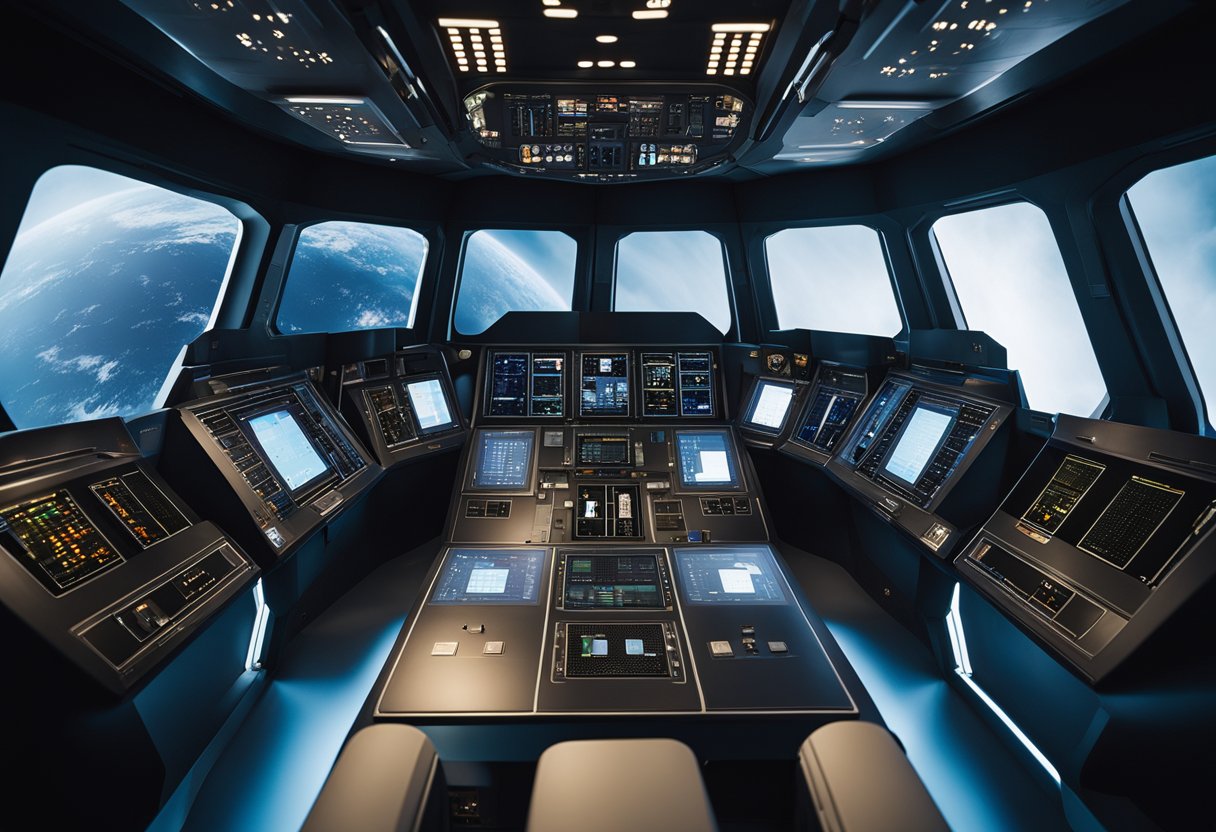
Simulation training plays an indispensable role in preparing both astronauts and crew members for the rigours of space missions. It encompasses a variety of training types, each designed to prepare for specific aspects of a mission, ranging from physical endurance to psychological resilience and execution of mission-specific tasks.
At the core of our simulation regimen are the Physical Training Elements, designed to ensure that astronauts’ bodies can withstand the conditions of space. This includes rigorous exercise protocols that mimic the absence of gravity and strengthen both muscular and cardiovascular systems. Safety is paramount, so we employ specialised equipment to simulate these conditions, ensuring muscle and bone density is maintained. Examples of this equipment include:
Psychological Training Focus addresses the well-being of astronauts and crew beyond the physical. Space missions can be both lengthy and isolated, and it’s critical that the individuals are mentally prepared for these challenges. Our training efforts include:
Task and Mission-Specific Training is tailored to the specific requirements of the mission at hand. Each task an astronaut will perform is rehearsed with precision, from operating spacecraft controls to conducting extravehicular activities (EVAs). This level of preparation ensures that once in space, every crew member is adept at:
We continually refine our simulation training based on feedback and lessons learned from previous missions to enhance future preparedness. This approach underpins the confidence required for the success and safety of space missions, benefitting not only professional astronauts but also the participants of pioneering space ventures, like those documented by SpaceVoyageVentures.com.
Simulated space missions are essential to prepare for the complexities of space travel. By recreating each phase of the mission, we ensure the safety and success of future spaceflights.
Pre-launch simulations are crucial for a successful mission. We meticulously check every system aboard the rocket, ensuring that both hardware and software meet stringent safety standards. Simulations include mock countdowns and system checkouts, which allow us to address any potential issues before actual launch day.
During launch and ascent simulations, we recreate the intense conditions experienced during a rocket’s journey from the ground into orbit. The main focus is on the rocket’s performance to endure the stresses of lift-off and to execute stage separations flawlessly.
Once the ascent is complete, the focus switches to orbital operations. This stage includes various manoeuvres such as orbit maintenance and systems management. Critical systems are tested in simulated zero-gravity conditions to guarantee functionality in space.
Simulating rendezvous and docking is particularly complex, requiring precise calculations and manoeuvres. Crew members practise these skills in realistic simulators that mimic the behaviour of spacecraft in orbit, ensuring they are prepared for the delicate task of docking with another spacecraft.
For the re-entry and landing phases, we conduct simulations that replicate the high-speed re-entry through Earth’s atmosphere and the critical moments before touchdown. This helps us refine our landing procedures and ensure the safety of the crew upon return to Earth.
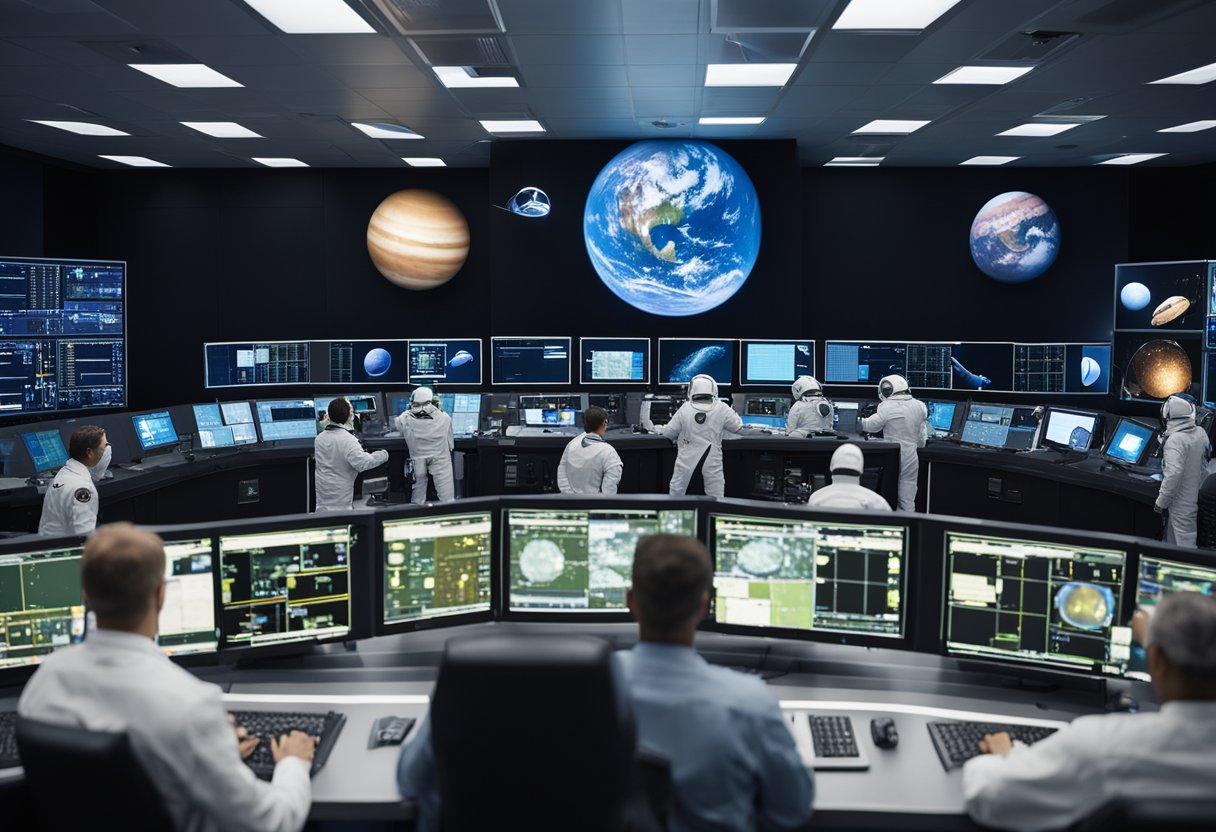
We understand the importance of advanced simulation facilities for space agencies. These facilities play a crucial role in preparing for the challenges of space missions.
The Johnson Space Center is pivotal to NASA’s endeavours in space mission simulation. It’s home to the ModSim facilities, which are integral in revising and enhancing our understanding of the Artemis program. The centre employs ModSim for various objectives, from mission planning to astronaut training. ModSim has also been crucial in retracing the historic Apollo missions and preparing for future explorations to Mars.
Canada’s Canadian Space Agency (CSA) contributes significantly to space mission simulations through its collaboration with other international space agencies. The CSA incorporates both cutting-edge technology and scientific research to facilitate these simulations. Canada’s unique geography has also been utilised for analogue missions that replicate the Martian terrain, augmenting the realness of these simulations and providing crucial data for future endeavours.
We also recognise that as space exploration advances, there is budding interest in space tourism. The emerging website, SpaceVoyageVentures.com, provides an insight into this exciting new venture, documenting the range of experiences, from those currently available to those that are on the horizon.
Before astronauts venture into space, they undergo extensive simulation training. We’ll explore how simulations prepare crews for operations on the International Space Station (ISS) and moon missions, incorporating replicable elements of space environments like microgravity, and the use of rovers and habitats in lunar scenarios.
Simulators play a crucial role in preparing astronauts for life and work aboard the ISS. For instance, the Systems Engineering Simulator at the Johnson Space Center equips astronauts with the skills to handle both routine operations and unexpected challenges they might face in the unique environment of space. Training includes managing the station’s complex systems, conducting scientific experiments and ensuring their own safety and that of their crewmates.
Astronauts designated for lunar missions engage in specially tailored simulation programs. From piloting a 3D lunar simulator to practising in-situ resource utilisation (ISRU), these training programmes replicate the moon’s surface conditions. Rover navigation and habitat management also form part of the preparations, honing skills that will be essential for the success of missions like NASA’s Artemis program.
We ensure that our information is confident and accurate by incorporating the most recent simulation practices and technological advances in space training. Through these detailed practice scenarios, astronauts become adept in the skills they will need on the international space station or when embarking on a lunar expedition.
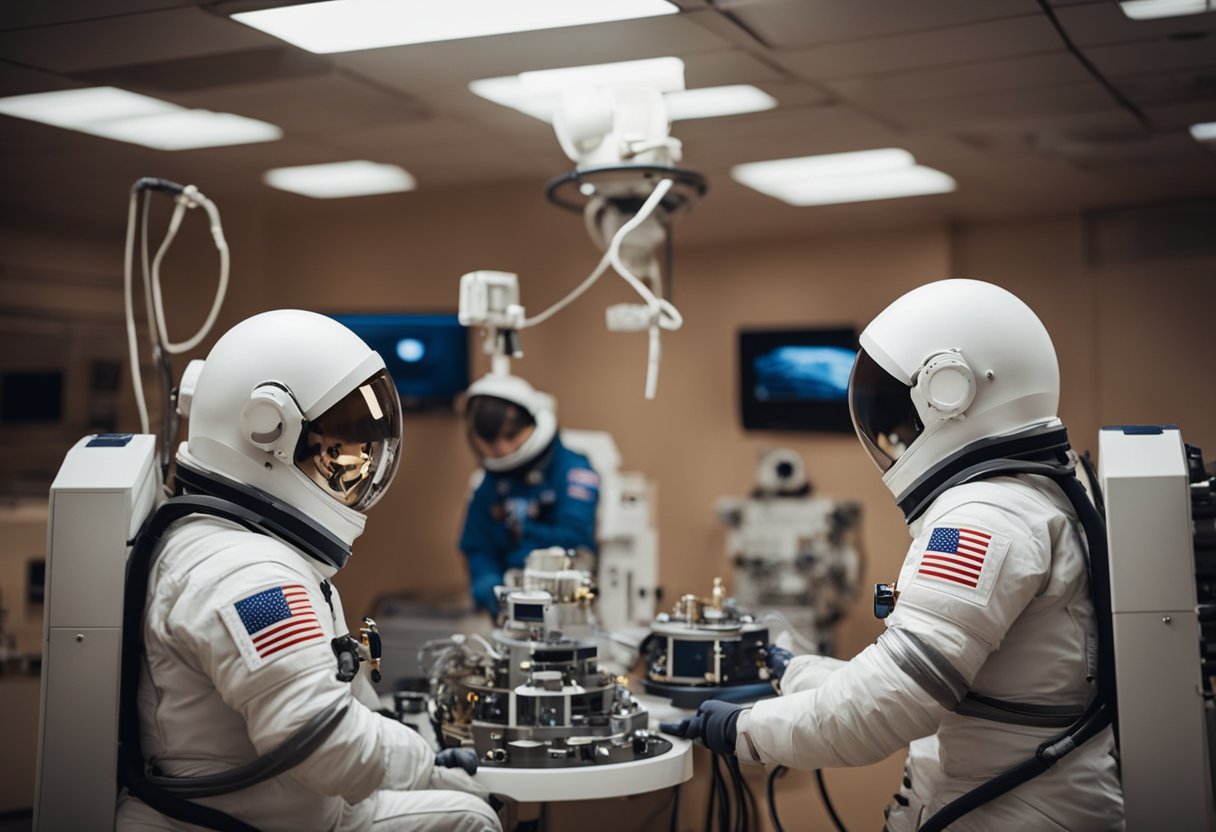
As we continue to venture into space, rigorous training and meticulous simulations are indispensable for preparing astronauts for the challenges of Mars missions. Our goal is to ensure a seamless transition from Earth to the Red Planet’s unique and unforgiving environment.
To simulate the environment of the Red Planet, we utilise various analog sites and virtual reality platforms. The NASA MarsXR Challenge is a pioneering initiative that crafts immersive simulations of Mars’ terrain and geological features, offering astronauts an opportunity to train in a realistic setting. A Mars mission demands adaptability to the planet’s lower gravity and an unfamiliar landscape, thus our simulations incorporate these aspects to prepare the crew for extravehicular activities, commonly known as spacewalks.
Mars analogue environments on Earth, like the one in Texas, assist in conditioning astronauts by mimicking Martian conditions. Here, teams are put in 3D-printed habitats, testing their ability to cope and work in confined spaces for extended periods, which is an inevitable part of life on Mars.
In preparing for Mars, exploration rovers are an inseparable part of the mission. Our simulations involve intricate scenarios where astronauts operate rovers, ensuring they are proficient in navigating the Martian surface and conducting scientific experiments. These simulations are supported by state-of-the-art software integrating various scenarios that will arise during the actual missions.
Astronauts also train in habitats designed to simulate living on Mars. NASA’s yearlong simulated Mars mission serves as a critical step in training for isolation, self-sufficiency, and remote operations. The habitat simulation focuses on replicating a Martian base, allowing astronauts to fine-tune their skills in habitat maintenance, life support operations, and other tasks crucial for long-term survival on Mars.
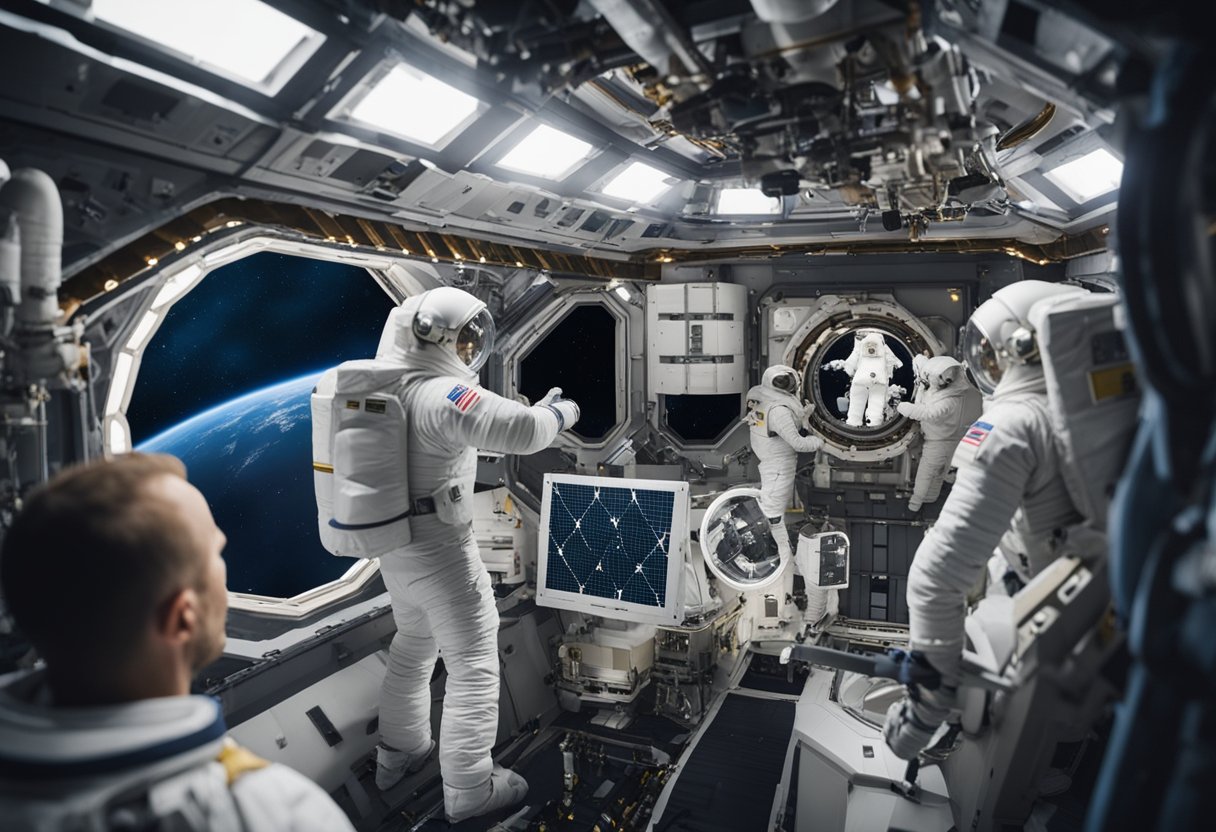
In the realm of commercial spaceflight, simulation training has become indispensable, ensuring astronaut readiness and safety for missions such as those conducted by SpaceX’s Crew Dragon and under NASA’s Commercial Crew Program.
SpaceX, a prominent entity in the commercial space industry, utilises advanced simulation technologies in preparing astronauts for the Crew Dragon missions. Through high-fidelity flight tests, we can replicate the complex conditions of space travel. These simulations are critical in providing crew members with realistic experiences, from navigating the spacecraft to managing on-orbit operations. Such rigorous preparations played a crucial role in the Demo-2 mission, marking a significant milestone as the first manned flight test under the Commercial Crew Program.
Our role within the Commercial Crew Program focuses on collaborating with industry partners like SpaceX to enhance astronaut training. The program mandates meticulous simulation requirements to complement flight tests, fortifying the readiness of crews for various mission scenarios. This symbiosis between commercial initiatives and agency-driven standards ensures a robust framework for present and prospective missions.
Current simulations are not only vital for our astronauts but also for the burgeoning space tourism industry. Websites like SpaceVoyageVentures.com provide a glimpse into the future of space travel, where training simulations might one day become part of the civilian spacefaring experience.
As we explore the universe beyond our atmosphere, technological advancements in simulation pave the way for an immersive experience. We can now replicate complex space missions through sophisticated simulations, shaping the future of astronautic training and public space exploration interest.
Virtual reality (VR) systems have transformed from simple gaming accessories to intricate tools in aviation and space mission preparation. Our use of VR extends to astronaut training, where we replicate the environment of space in high detail. This training is crucial for managing the unexpected challenges presented by the cosmos. We’ve seen how it enhances spatial awareness and fine motor skills, which are essential for extravehicular activities.
In the realm of public engagement, platforms like SpaceVoyageVentures.com allow the public to experience what space travel may entail, including missions that are currently or soon-to-be available for aspiring space tourists.
We’re witnessing the emergence of a new tier of simulation technologies. These systems incorporate advances in computer graphics and physics engines, thus creating highly accurate models of spacecraft behaviour, celestial body motion, and atmospheric conditions. Hardware innovation plays a pivotal role here, as more powerful processing units enable us to simulate environments with unprecedented realism.
Simulation technologies are not solely limited to training astronauts. In the gaming industry, we utilise these innovations to create engaging, realistic experiences for users, often inspiring the next generation of space enthusiasts and professionals. Through these simulations, we’re preparing ourselves for a future where space travel may become as routine as air travel.
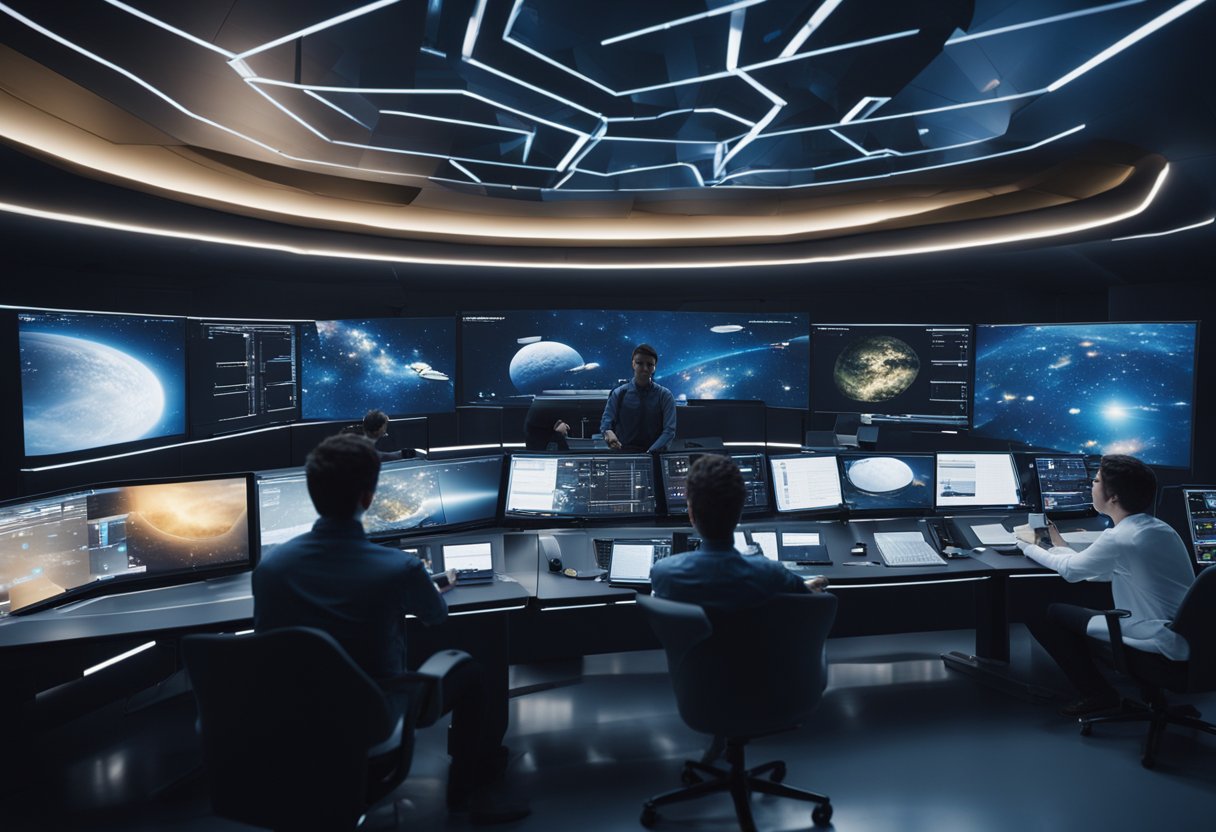
Incorporating simulations into both educational environments and public outreach initiatives, we provide a unique conduit for immersive learning experiences and engagement in space missions. Simulations breathe life into theoretical knowledge and validate lessons learned through virtual spacecraft operations and mission management.
Educational simulations are crucial in delivering practical insights into the complexities of space missions. Programs like NASA’s Analog Missions serve to bridge the gap between theory and practice, allowing students to conduct simulated asteroid missions or partake in lunar in-situ resource utilisation field tests.
Additionally, we’ve seen initiatives where NASA Office of Space Science’s educational outreach inspires students to pursue STEM careers, with hands-on exploration simulations offering them a taste of space exploration. Through programs like FY23 NCAS Mission 2: Explore, students can design solutions for Moon or Mars missions, fostering a robust understanding of interplanetary travel and systems integration.
We employ simulations to captivate and educate the public. These engaging experiences, such as those illustrated by the Deep Impact mission’s public outreach, underscore physical principles in an interactive format, facilitating a deeper understanding of the science behind missions.
We also consider the evolving dimension of space tourism, as portrayed by SpaceVoyageVentures.com, where the public can acquaint themselves with current and near-future space travel opportunities. This platform elucidates not only the reality of today’s space tourism but also fosters anticipation for imminent advancements.
In our pursuit of space exploration, we utilise simulations to ensure the safety of the crew and the operational efficiency of the spacecraft. These simulations are critical for replicating the complexities of space environments.
Simulations allow us to test and refine safety protocols and emergency procedures, ensuring that every conceivable scenario is accounted for. Through rigorous virtual exercises, crew members develop the proficiency needed to respond effectively to emergencies. For instance, by simulating off-nominal conditions such as cabin depressurisation or system failures, we can evaluate the crew’s response times and the effectiveness of their actions under pressure.
The readiness of the spacecraft and crew is paramount. Before a mission, we simulate the full range of operational tasks to verify the spacecraft’s systems and ensure that the crew are prepared for the demands of the mission. The evaluation of analog space missions’ risk analysis aids us in identifying potential risks, which in turn informs our strategies for risk mitigation and the establishment of reliable mission parameters.
Each simulation informed by real-world flight tests offers invaluable lessons. By analysing the outcomes, we enhance both our methodologies and the spacecraft’s design for future missions. The insights gained from Hit-in-the-Loop (HITL) simulations, where we assess the effectiveness of flight control laws and cockpit displays, are instrumental for advancing our safety measures and operational protocols. Such simulations are key to ensuring that future space missions, including those detailed on SpaceVoyageVentures.com, are both safe for tourists and crew, and successfully meet mission objectives.
In this section, we address some of the most common queries about the Shuttle Launch Experience, providing insight into what participants can expect from these simulations.
The Shuttle Launch Experience is meticulously crafted to mirror the sensations of an actual shuttle launch. It combines physical motion, visual effects, and sound design to create an immersive simulation that replicates the spacecraft’s ascent into orbit.
Yes, it is not uncommon for visitors to feel a degree of apprehension during the Shuttle Launch Experience. The simulation’s realistic depiction of a shuttle launch can evoke a strong emotional response akin to what astronauts may feel.
The g-force levels replicated in the Shuttle Launch Experience are carefully calibrated to be strong enough to simulate the feel of a launch while still being safe for participants. These levels typically simulate the lower end of what astronauts experience during a real launch.
Common reactions to the simulated motion during the Shuttle Launch Experience include excitement, surprise, and exhilaration, as participants feel the rush of the simulated launch sequence and the ground falling away.
There are a range of digital platforms that offer simulated experiences of Mission Control, including interactive websites and applications that allow users to engage with various aspects of spacecraft operations.
Absolutely, there are educational space simulation programmes specifically designed for students that integrate STEM learning with hands-on experience. These programmes emulate the roles of scientists and engineers, allowing students to apply their knowledge in a practical setting.